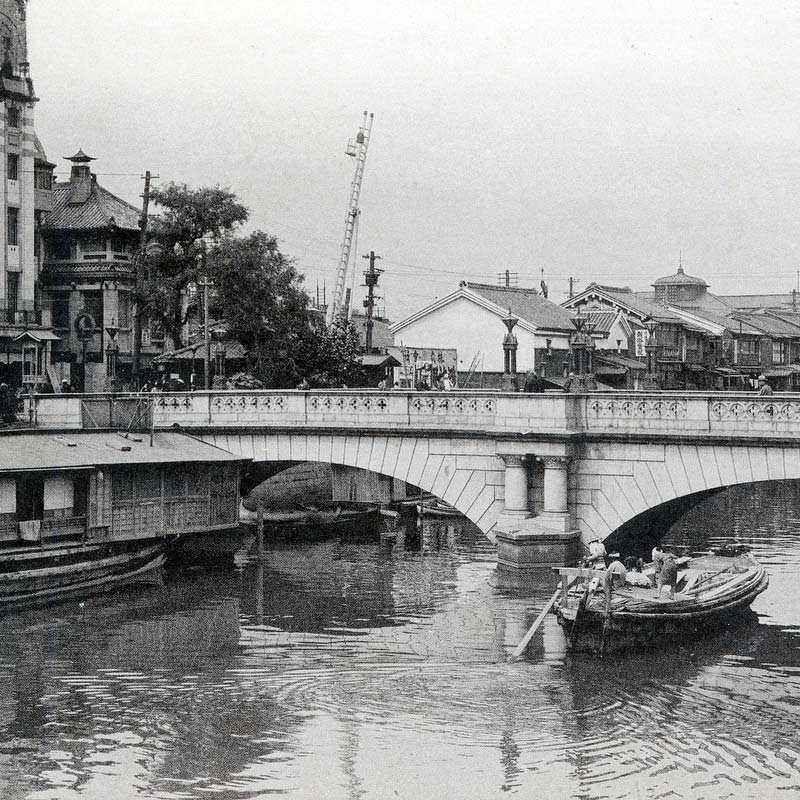Shinsaibashi bridge in Osaka, Japan. View towards Kita.
The area across the bridge was famous for its many book shops. The large buildings in the back are the Buddhist temples Kita Mido and Minami Mido. The Western building on the left is the telegraph branch office.

The Shinsaibashi area was located nearby the red light district of Shinmachi and the theater district of Dontonbori. As a result, it prospered as a busy shopping street. There were stores selling lacquer-ware, books, antiques, instruments, paperhangers, and ornaments. The famed kimono store Matsuya, later to become the large department store chain Daimaru, was located on Shinsaibashi-dori, the street from which this photo was taken.
The Western-style iron bridge was imported from Germany in 1873 (Meiji 6) and was 37.1 meters long and 5.2 meters wide. It was the second largest bridge in Osaka and the 5th largest in Japan.
It replaced a 35-meter long and 4 meter wide wooden bridge built in 1622 (Genna 8) by Shinsai Okada (岡田心斎)—after whom the bridge is named. He was one of four merchants who dug the Nagahori canal. The steel bridge was replaced by a stone bridge in 1909 (Meiji 42).1

The Nagohori canal was reclaimed in 1964 (Showa 39), creating Nagahori-dori. Simultaneously, the stone bridge was converted into an overpass. What was once a picturesque canal, now turned into a busy thoroughfare full of noisy cars. A beautiful part of Osaka had vanished forever.2
The original iron bridge was reconstructed in 1973. It was placed in Osaka’s Tsurumi Ryokuchi in March 1989.3
In 1997, an underground shopping and amusement mall was built where the canal used to be. It cost a whopping JPY 77 billion (USD 700 million). Sections of the stone bridge became part of the pedestrian crossing.4
About one-third of the 730 meter long shopping arcade has a glass ceiling with water flowing on its surface. The parts of the bridge and the water must make people feel as if the canal never disappeared…
Notes
1 Shinsaibashi-suji Shopping Center Promotion Association, History Library. Retrieved on 2007-03-30
2 Osaka City, 心斎橋(しんさいばし). Retrieved on 2008-02-03
3 Osaka City, The Original Shinsaibashi Bridge. Retrieved on 2007-03-30
4 Kippo, Trompe l’oeil brook to flow under Shinsaibashi Bridge. Retrieved on 2007-03-30
Published
Updated
Reader Supported
Old Photos of Japan aims to be your personal museum for Japan's visual heritage and to bring the experiences of everyday life in old Japan to you.
To enhance our understanding of Japanese culture and society I track down, acquire, archive, and research images of everyday life, and give them context.
I share what I have found for free on this site, without ads or selling your data.
Your support helps me to continue doing so, and ensures that this exceptional visual heritage will not be lost and forgotten.
Thank you,
Kjeld Duits
Reference for Citations
Duits, Kjeld (). Osaka 1890s: Shinsaibashi Bridge, OLD PHOTOS of JAPAN. Retrieved on December 12, 2025 (GMT) from https://www.oldphotosjapan.com/photos/1/osaka-1880s-shinsaibashi-bridge




Henk Veenstra
Kjeld,
Jouw initiatief om oude foto’s op het internet te publiceren vind ik top.
Groetjes, Henk
#000004 ·